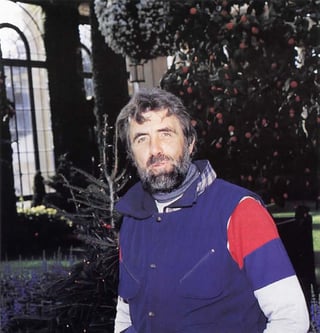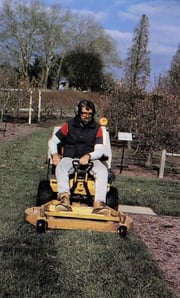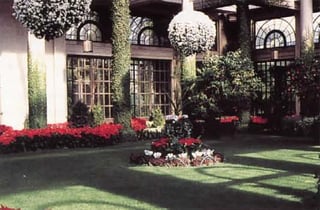When Pierre S. du Pont bought Longwood in 1906, initial plans didn't call for developing his new property into the world's premier horticultural display gardens. Today, however, Longwood Gardens is just that. Located 30 miles west of Philadelphia in historic Brandywine Valley, Longwood features 1,050 outdoor acres and 20 indoor gardens. In addition to the 11,000 different kinds of plants that comprise the displays, the gardens have become a horticultural research center, a center of continuing education and a home for an extensive performing arts program where more than 400 musical and theatrical events are scheduled each year.
 But the flowers and other beautifully landscaped elements are the main attraction for the 800,000 visitors who come to Longwood annually. And few people know the terrain better than senior groundskeeper Henry Schweibenz. A 32-year veteran of numerous plantings, events, renovations and other maintenance and installation callings, Henry knows what it takes to keep his neighborhood groomed and growing.
But the flowers and other beautifully landscaped elements are the main attraction for the 800,000 visitors who come to Longwood annually. And few people know the terrain better than senior groundskeeper Henry Schweibenz. A 32-year veteran of numerous plantings, events, renovations and other maintenance and installation callings, Henry knows what it takes to keep his neighborhood groomed and growing.
He names the different exterior gardens without missing a beat. "Let's see, there's the Topiary Garden, Rose Garden, Flower Garden Drive and Walk, Water Garden, Wisteria Garden and Peony Garden." He pauses, then rushes to add the Hillside Garden, Peirce's Park and the Idea Garden which features ideas and information for the home gardener. The tight places throughout this setting are maintained by Walker mowers, he tells. Longwood employs two Walker mowers, one with a 42-inch deck, the other with a 48-inch deck.
Then there are the wide, open spaces - lots of them - where maintenance crews look to their wide-area and front-cut Toros, Jakes and Ransomes to get the job done. There is even grass inside the conservatory where electric mowers get the call.
The entire landscape setting at Longwood, with its magnificent trees, flowers and lush grass, is maintained rigorously, along with the physical structures which require constant vigilance. The Italian Water Garden, for example, was recently rebuilt at a cost of more than $4 million and the Main Fountain Garden is scheduled for a similar overhaul. By the year 2000 an estimated $45 million will have been spent on physical plant restoration alone. Longwood offsets half its annual operating expenses of $20 million from admission, garden shop sales, education programs, rentals and restaurant income. A du Pont endowment funds the rest.

Ideal Setting
 Henry remembers they purchased their first Walker in 1990 after the groundskeeping foreman saw the mower being used by a mowing contractor. "In about two day time, I was mowing in and around the gardens," he relates. "Before the Walkers, we used five push mowers. We'd start at one end of the gardens and just mow. We don't use the push mowers anymore, except for a couple of areas where we can't drive the riders."
Henry remembers they purchased their first Walker in 1990 after the groundskeeping foreman saw the mower being used by a mowing contractor. "In about two day time, I was mowing in and around the gardens," he relates. "Before the Walkers, we used five push mowers. We'd start at one end of the gardens and just mow. We don't use the push mowers anymore, except for a couple of areas where we can't drive the riders."
In many ways, the beautiful garden setting is ideal for the Walker. Scalping, turf damage and tree scrapes are out of the question. Yet being able to maneuver around obstacles and still be productive is a requisite. Collection is a necessity, too, where the alternative would be removing leaves and clippings from the beds. There's even a compost facility right on site to take care of the clippings and leaves.
Added Challenge
But keeping a beautiful landscape manicured is not the only challenge for maintenance crews. As Henry's supervisor and groundskeeping and tree division head Phil Gruszka points oul, "With so many visitors daily, equipment operators have to pay special attention to people. as well." Over the years. he adds. Longwood has altered its mowing schedule to accommodate visitors and keep noise to a minimum. Yet, with the garden being open 365 days a year and from 9 a.m. to 6 p.m. throughout tile growing season, it's difficult to find a spot to mow without a visitor standing nearby. As Henry tells, operators always have to be on their guard. "If I see someone approaching, I'll shut the machine down just to be safe and courteous," he adds.
 Maintaining a couple hundred acres of outdoor gardens would be a challenge for any maintenance crew. Longwood has 55 gardeners on staff, along with a total workforce of 444 full - and part-time employees, students and volunteers. Maintenance crews mow from spring to the middle of December, and winter keeps them busy with snow removal, pruning projects. and equipment maintenance. With that kind of schedule, it's a wonder employees ever have time to enjoy the surroundings. Worse yet, lhey might learn to take the scenery for granted. "Not a chance," saysHenry. "There's one thing about a growing environment. It's always changing and offering new challenges." In Longwood's case, the changes are just that much more magnificent.
Maintaining a couple hundred acres of outdoor gardens would be a challenge for any maintenance crew. Longwood has 55 gardeners on staff, along with a total workforce of 444 full - and part-time employees, students and volunteers. Maintenance crews mow from spring to the middle of December, and winter keeps them busy with snow removal, pruning projects. and equipment maintenance. With that kind of schedule, it's a wonder employees ever have time to enjoy the surroundings. Worse yet, lhey might learn to take the scenery for granted. "Not a chance," saysHenry. "There's one thing about a growing environment. It's always changing and offering new challenges." In Longwood's case, the changes are just that much more magnificent.





 Site Search
Site Search



